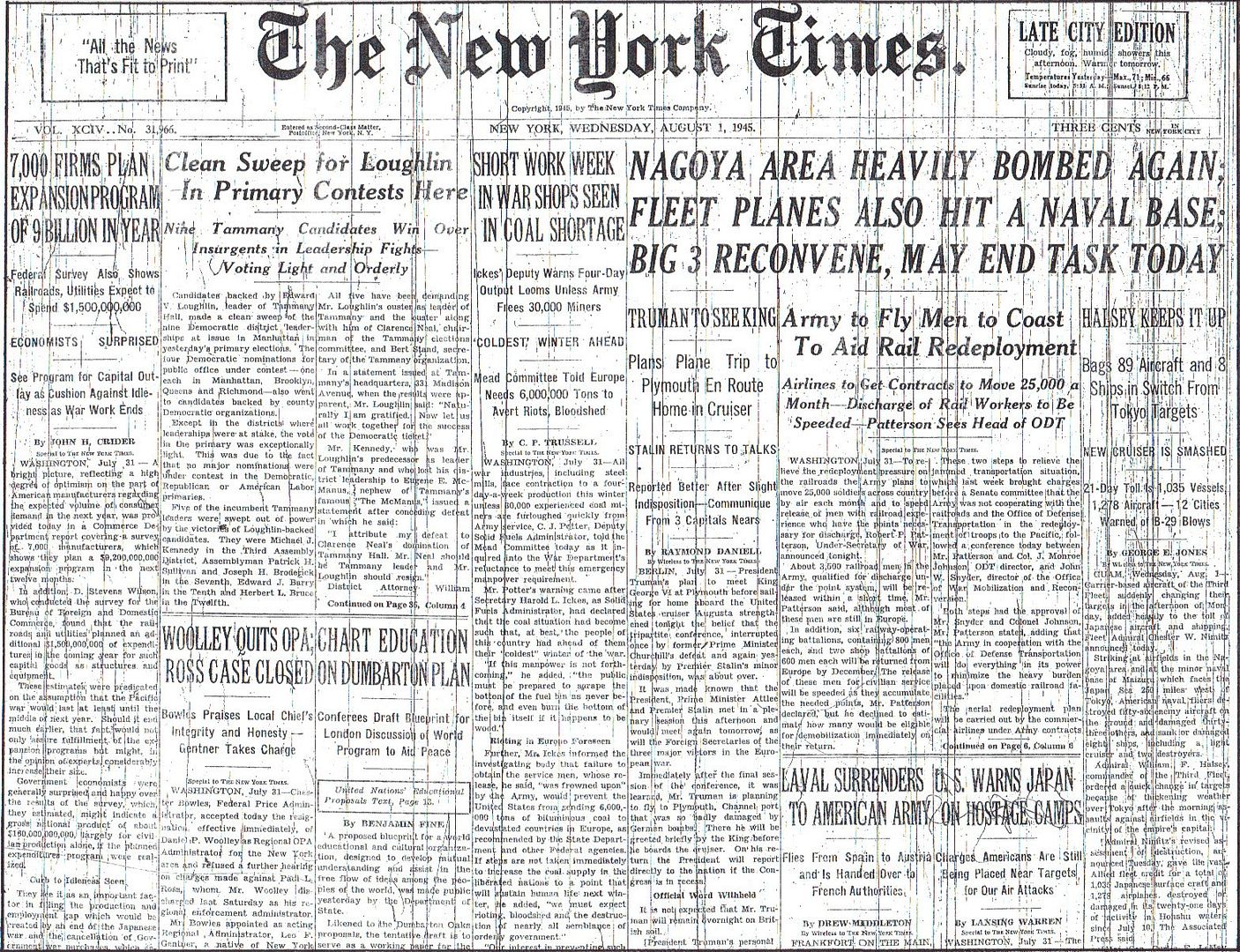
Posted on 08/01/2015 4:52:36 AM PDT by Homer_J_Simpson

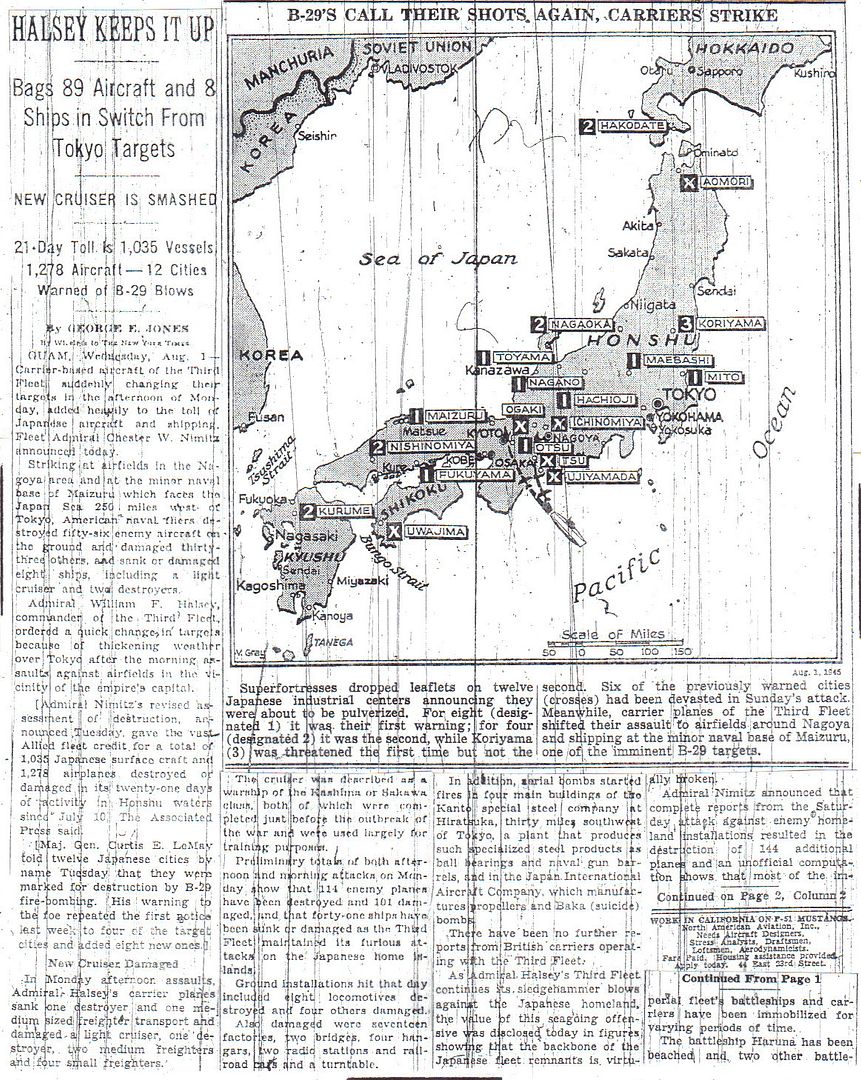
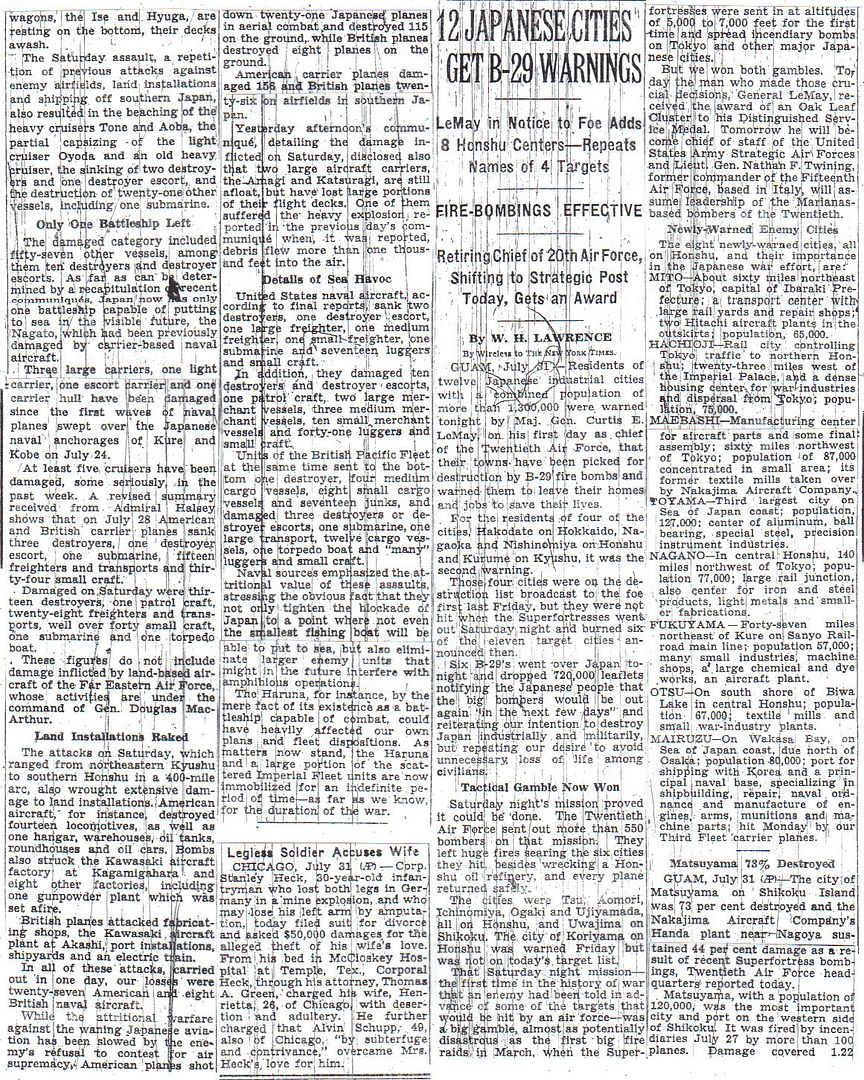
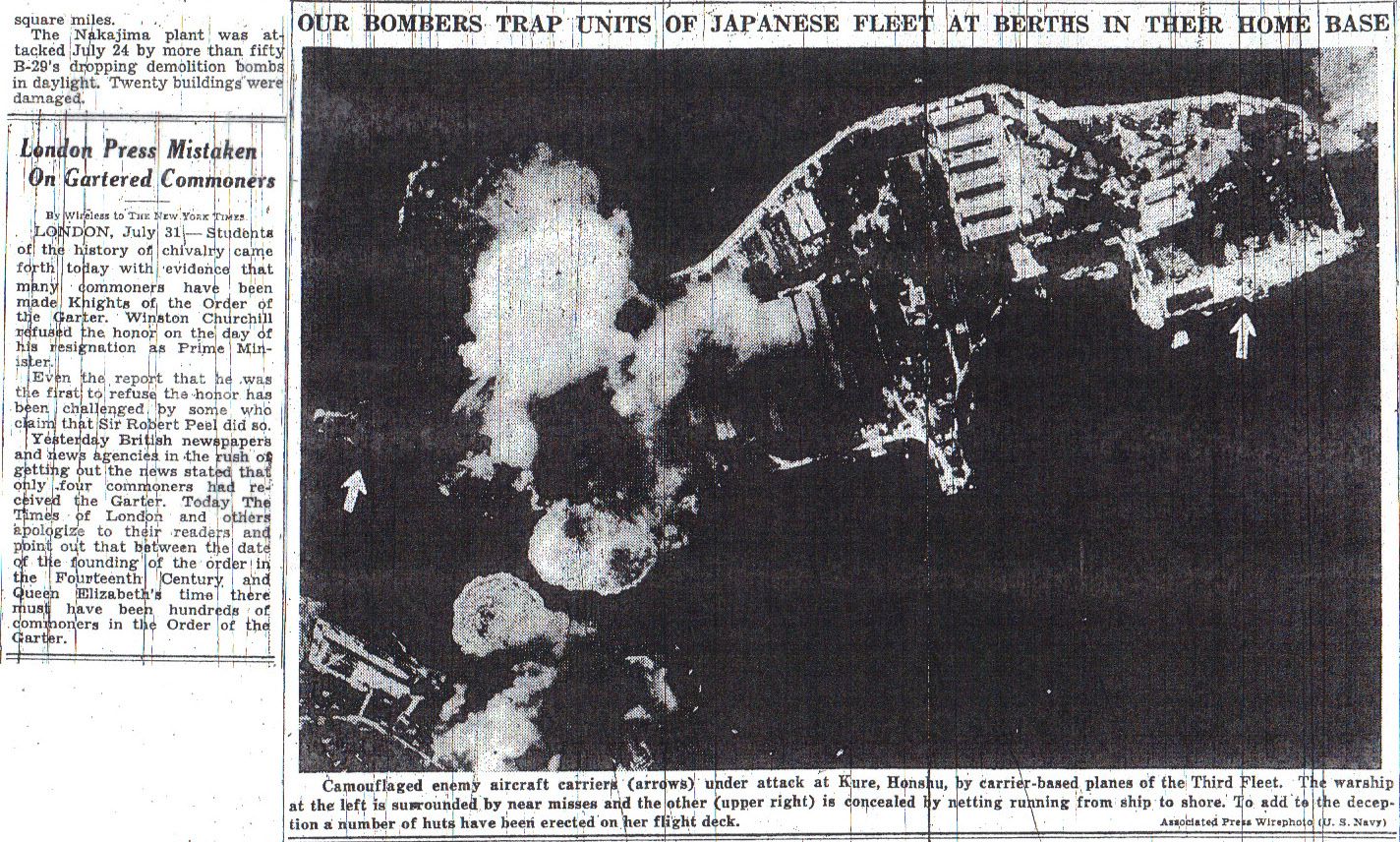

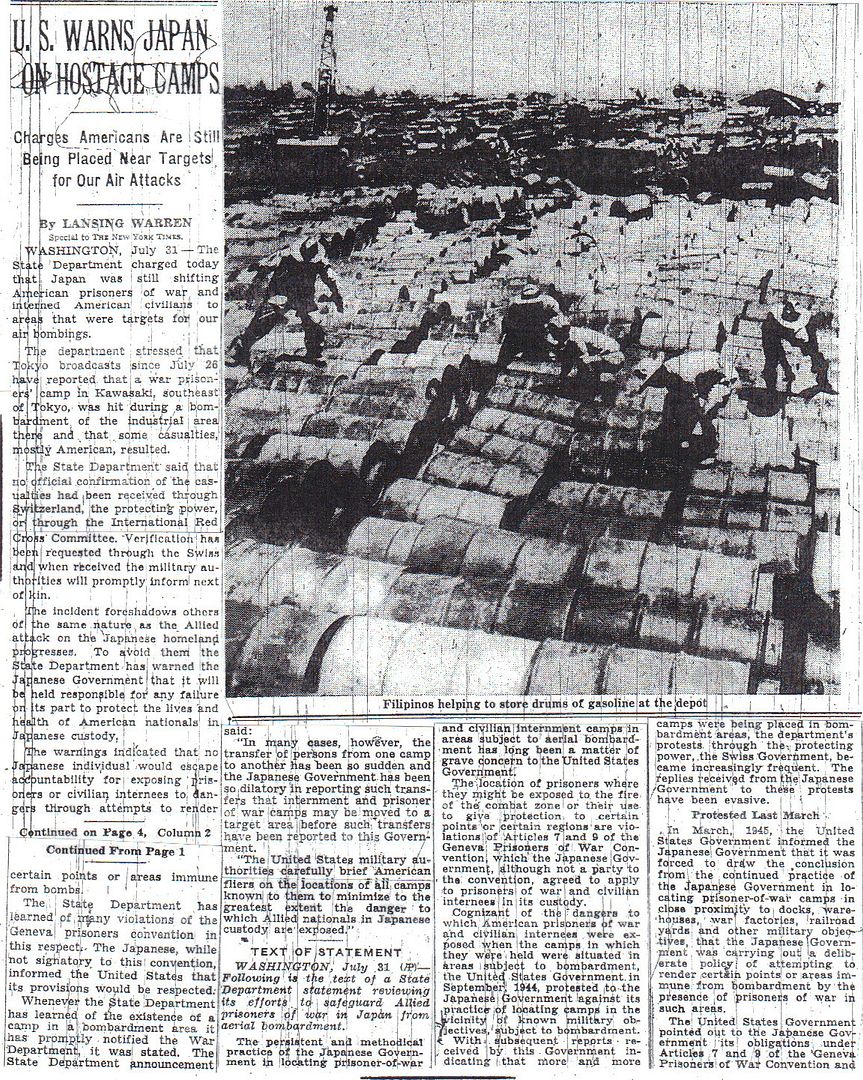
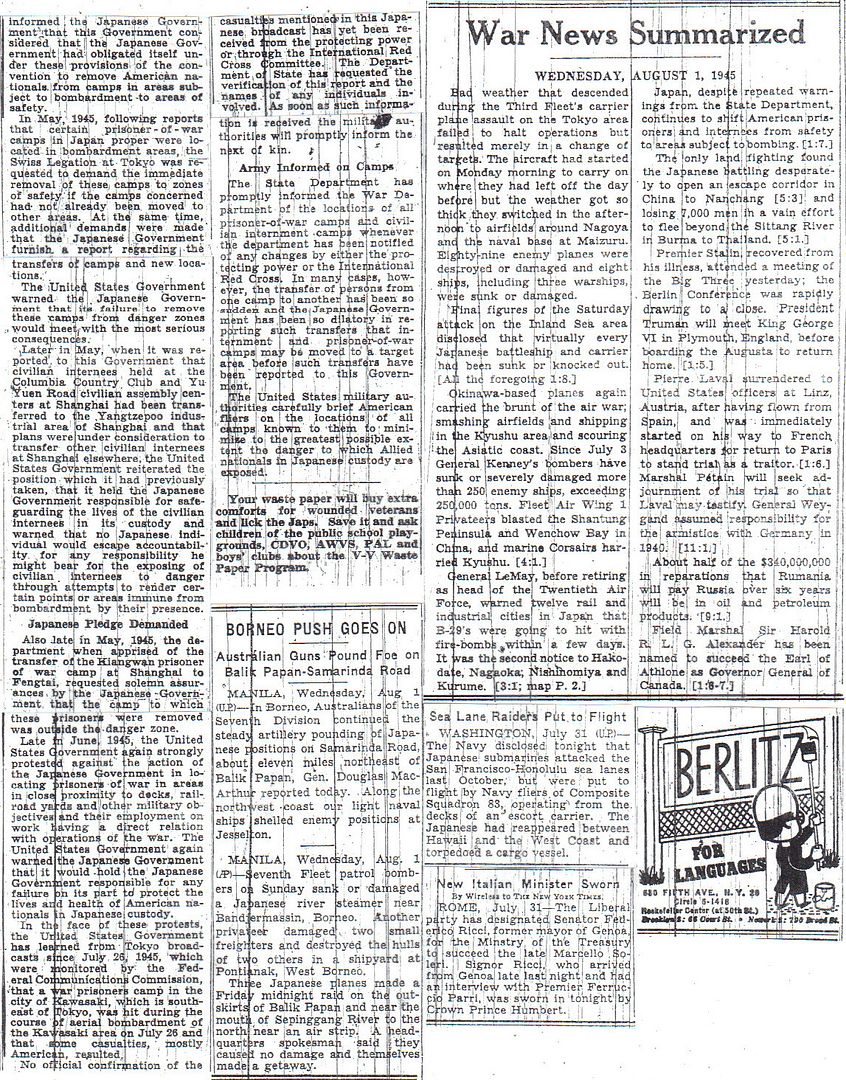
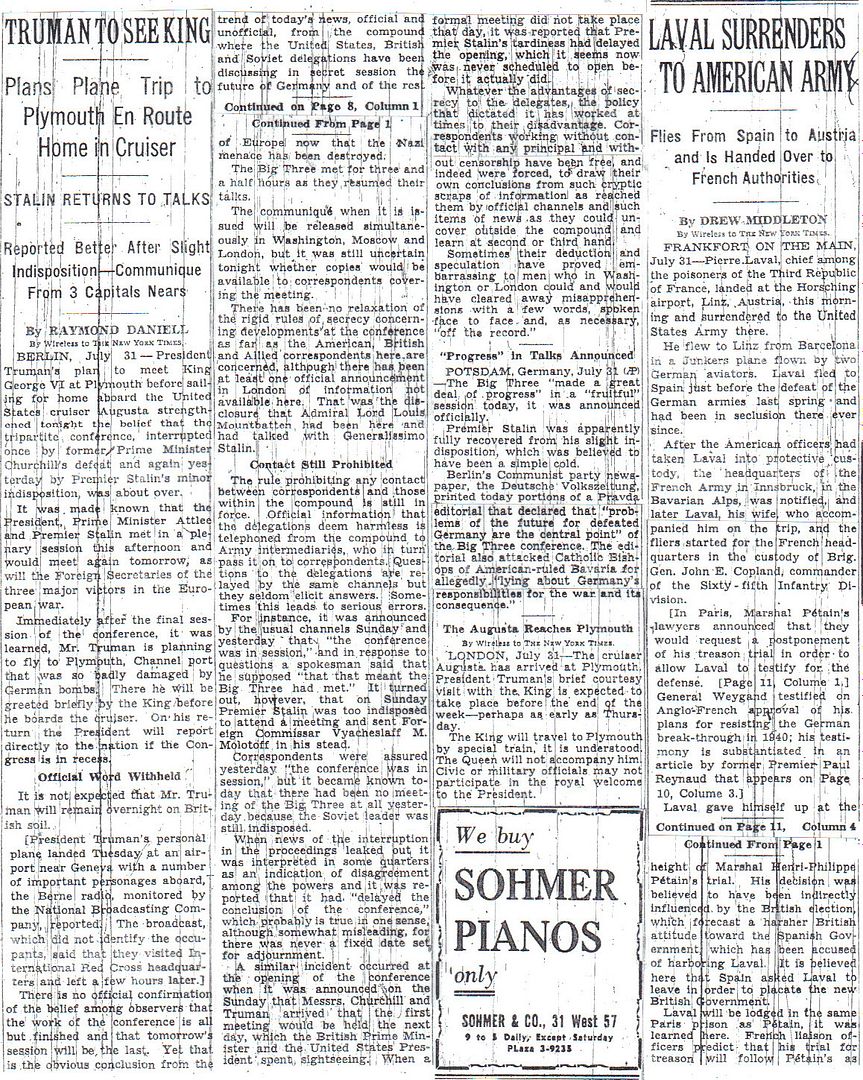
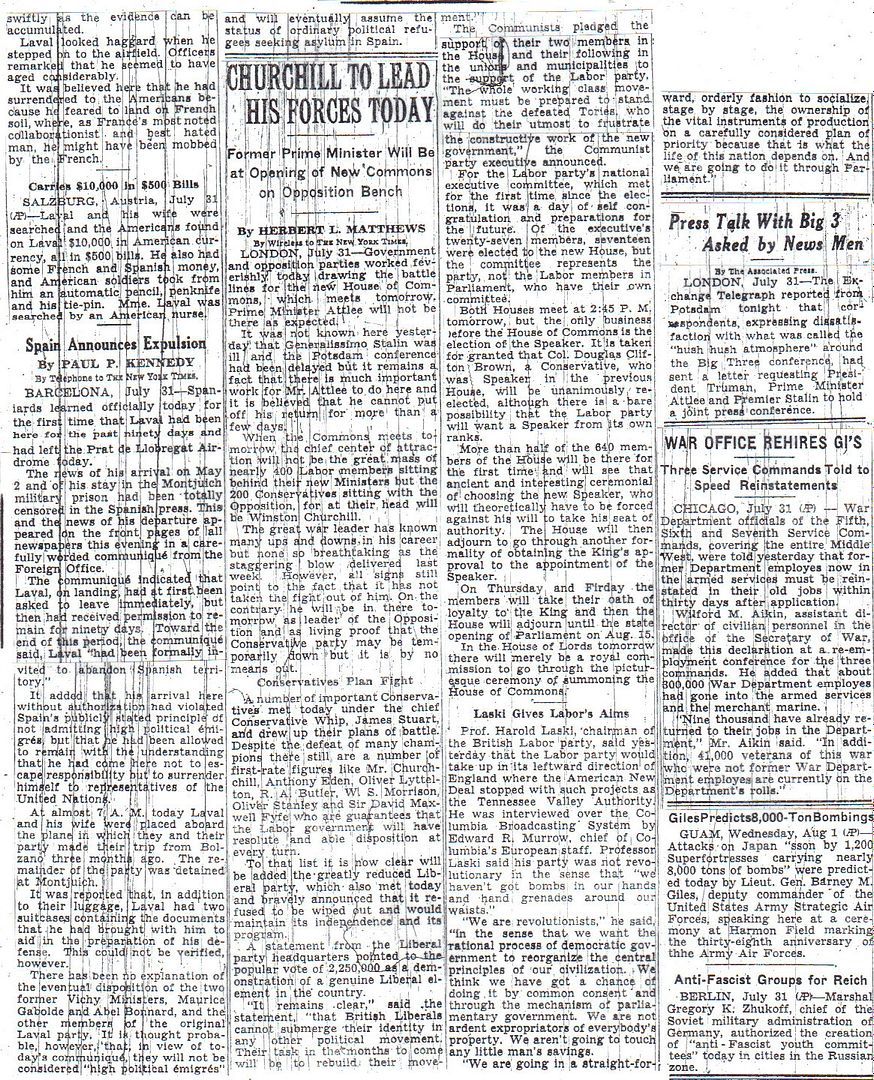

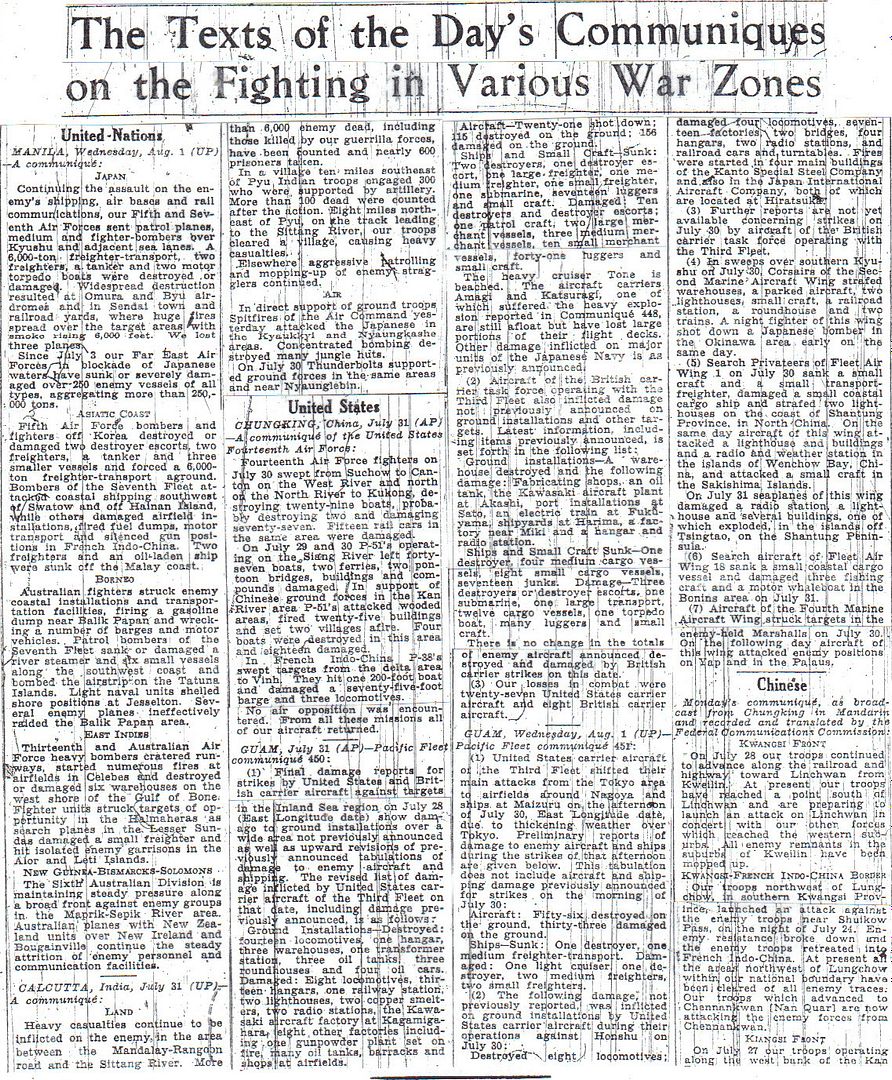

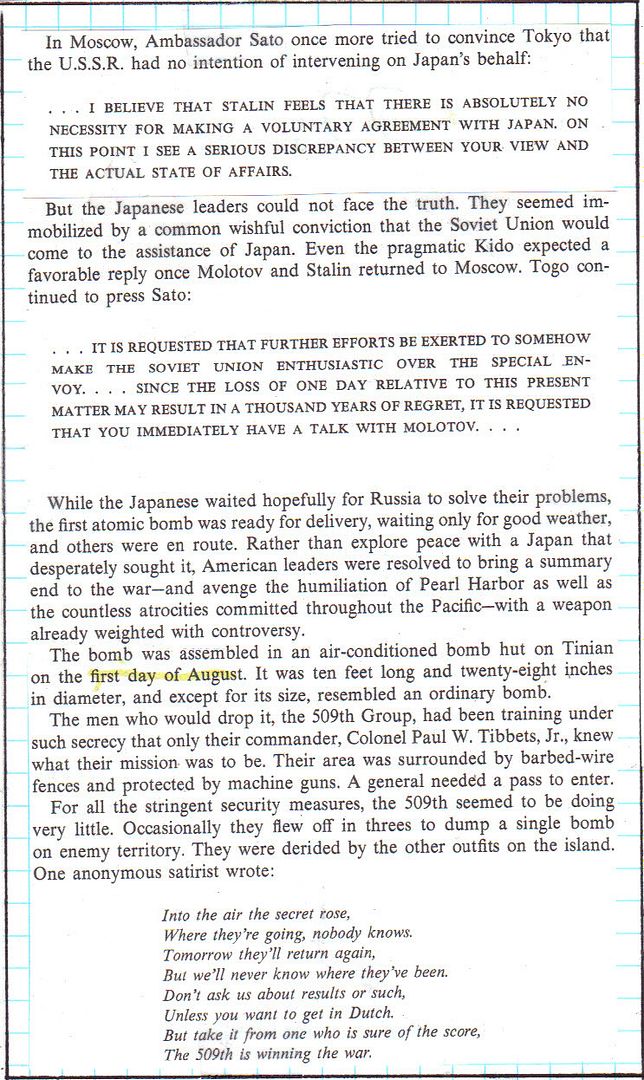
John Toland, The Rising Sun: The Decline and Fall of the Japanese Empire, 1936-1945
August 1st, 1945
UNITED KINGDOM: Thousands of British girls are waiting for ships to take them to the US to marry the American servicemen who proposed during their tours of duty in Britain. Some 20,000 couples have already “taken the plunge” in Britain, and the total of “GI Brides” is likely to reach 80,000. The American Red Cross is running “schools for brides”. Although their pay and their standard of comfort caused jealousy amongst their allies, the GIs’ popularity with the opposite sex never wavered in spite of the well-known taunt of being “overpaid, over-sexed and over here” and jokes about their effect on girls’ knickers - “one Yank and they’re off.”
Westminster: Labour MPs sing The Red Flag as the House of Commons meets to elect a new speaker.
FRANCE: Paris: Pierre Laval is returned to the city, charged with treason and placed under armed guard to protect him from the French public.
CHINA: Allied mines, dropped by air, bring Japanese shipping on the Yangtze river to a halt.
Major General Albert F Hegenberger becomes Commanding General Tenth Air Force as HQ Tenth Air Force moves from Piardoba, India to Kunming, China (HQ at Kunming was officially opened on 23 July). The scheduled role of the Tenth Air Force in China is almost identical with its completed Burma mission: to act as the tactical air force giving direct support and providing air supply to Chinese ground forces operating south of 27N latitude.
JAPAN: During the night of 1/2 August, the US Twentieth Air Force dispatches 836 B-29s to carry out 1 mining, 5 fire-bomb and 1 bombing raids on Japan; 1 B-29 is lost.
- Mission 305: 37 B-29s drop mines in Shimonoseki Strait, in Nakaumi Lagoon, at Hamada, Sakai, Yonago, Najin, and Seishin; 5 others mine alternate targets.
- Mission 306: 169 B-29s attack the Hachioji urban area destroying 1.12 sq mi (2.9 sq km), 80% of the city; 3 others hit alternate targets; 1 B-29 is lost.
- Mission 307: 173 B-29s hit the Toyama urban area, a centre of aluminium, ball bearing and special steel production, destroying 1.87 sq mi (4.84 sq km), 99.5% of the city; 1 other hits an alternate target.
- Mission 308: 125 B-29s attack the Nagaoka urban area destroying 1.33 sq mi (3.37 sq km), 65.5% of the city; 5 others hit alternate targets.
- Mission 309: 160 B-29s hit the Mito urban area destroying 1.7 sq mi (4.4 sq km), 65% of the city; 1 other hits a target of opportunity.
- Mission 310: 120 B-29s bomb the Mitsubishi Oil Company at Kawasaki but could only add slightly to the damage previously inflicted; 2 other hit targets of opportunity.
In Japan:
- 30+ Iwo Jima-based P-51s of the VII Fighter Command hit airfields and other targets in the Osaka-Nagoya area; bad weather prevents numerous other fighters from reaching targets.
- About 50 Far East Air Force B-24s bomb targets in the Nagasaki dock and harbour area; B-25s and fighter-bombers in the Nagasaki area hit docks, railroad yards, and shipping; other B-24s bomb Koniya Airfield and hit Kakeroma Island.
- 80+ P-47s hit railroad bridges and other railroad targets at Sendai and P-47s fly their first combat mission from Iwo Jima, joining VII Fighter Command P-51s in a sweep over southern Honshu Island; and rolling stock and airfields are attacked in the Okazaki, Itami, and Nagoya areas.
US Navy Task Group 95.2 consisting of the large cruisers USS Alaska (CB-1) and USS Guam (CB-2), 4 light cruisers and 9 destroyers, departs Okinawa to conduct an antishipping sweep in the East China Sea. Accompanying TG 95.2, is TG 95.3 consisting of 3 battleships, a heavy cruiser, a light cruiser, 3 escort aircraft carriers, 6 destroyers and 3 destroyer escorts.
COMMONWEALTH OF THE PHILIPPINES: In Manila, General of the Army Douglas MacArthur and Fleet Admiral Chester W. Nimitz meet and agree on a line of demarcation to separate aerial operations undertaken by their forces. Except for B-29s and their escorts, the Far East Air Forces will operate west of 135W longitude and all Pacific-fleet controlled units will operate east of 135W longitude. Longitude 135W is slightly west of Kobe and Osaka on Honshu Island.
MARIANAS ISLANDS: While a select band of politicians and military chiefs wrestles with the problem of whether or not to drop the atomic bomb, another select group has been practising carrying out the task, if ordered to do so. Bombers from the specially-formed 509th Composite Group have been making practice raids on Japan since 20 July. An advance party from the group, which was formed in December last year, had arrived in the Marianas on 29 May and in June was reinforced by the B-29s of the USAAF’s 393rd Squadron of Very Heavy Bombers. The 509th is commanded by Col. Paul Tibbets, who would lead any initial A-bomb attack.
SOLOMON ISLANDS: Allied troops seal off Japanese forces at Buin, on the southern tip of Bougainville.
WAKE ISLAND The USN’s Task Group 12.3 consisting of the light aircraft carrier USS Cabot (CVL-28) with Light Carrier Air Group Thirty Two (CVLG-32), the battleship USS Pennsylvania (BB-38) and a destroyer screen, bombs and bombards the island. This is the 7th attack on the island by the USN. The Japanese return fire and the Pennsylvania is damaged.
CANADA: Minesweeper HMCS Cedar Lake launched Toronto, Ontario.
HM S/M Unruffled arrived Digby, Nova Scotia for ASW training.
U.S.A.: Vol III No 12 Believed to be last issue of US Intelligence Bulletin is Published. (Bill Howard)
Baseball: New York Giants manager and right fielder Mel Ott hits his 500th career home run off Boston Braves’ pitcher Johnny Hutchings during a 9-2 Giants victory at the Polo Grounds in New York City. Ott is the third major league baseball player to hit 500 home runs. Ott bats .308 with 21 home runs this year as the Giants finish in fifth place.
During WW II, the Military Intelligence Service (MIS) produced numerous documents, most commonly known are the Intelligence Bulletins. The Military Intelligence Special Series continues with “The Punch Below the Belt.” and “Japanese Tank and Antitank Warfare.” (William L. Howard)
Minesweeper USS CRAIG is commissioned.
MEXICO: Lineas Aereas Mineras Boeing 247D, msn 1723, registered XA-DUY, crashes into a mountain near San Luis Potosi; all 12 aboard the aircraft are killed.
It Will Not Be Too Little and Too Late When D-Day Comes in the Pacific (photos) – 5-6
WOW!
There’s a book waiting to be written about the experience of all those thousands of WW2 war brides back here in the US.
My father would have been mines sweeping on both Olympic and Coronet invasions.
Thank God for the A-bomb.
Quartermaster Supply in the Pacific During World War II
http://www.qmfound.com/qmcpacific.htm
Amphibious operations and fighting along narrow strips of beach, or continuous movement through dense jungles and over steep mountain ranges discouraged the use of A-Rations (fresh foods) or B-Rations (canned stores) both of which had to be prepared by a trained cook. In such circumstances, mobile kitchens could not have kept up, and roads would not have allowed even quarter-ton trucks loaded with marmite cans to reach everyone. Harsh weather and terrain oftentimes precluded even the carrying of hot food by hand or with pack animals. The only solution was to provide combat troops with sufficient amounts of individual rations, which they could carry and prepare themselves.
Quartermaster R&D food specialists labored to meet the specialized needs and unique requirements of troops fighting in the Pacific. They came up with much improved C-Rations; lightweight “jungle rations” and K-Rations (both of which troops regarded as “picnic lunches”); high-energy, chocolate bars called D-Rations (for emergency uses only); and Assault Rations (often referred to as “candy rations”) tailor made for amphibious warfare. These helped ease the storage and distribution burden, while providing commanders with increased flexibility.
They learned from after action reports, for example, that most individual duffle bags and interchangeable pouches (which held all the soldiers’ personal goods) deteriorated in almost no time when dumped on beaches without proper storage. Or quickly got lost, or mixed up in the mayhem. Or they were shamelessly pilfered there on the beach, or while en route to unit dumps, due to lax security. After witnessing this experience, supply personnel gradually moved away from the use of individual bags, and came up with new methods of storing personal clothing and equipment in easier to control and protect squad-size bags. pacific19.jpg (62889 bytes)This was only one of many lessons – big and small – learned by Quartermaster supplymen during the war.
“Baseball: New York Giants manager and right fielder Mel Ott hits his 500th career home run off Boston Braves’ pitcher Johnny Hutchings during a 9-2 Giants victory at the Polo Grounds in New York City. Ott is the third major league baseball player to hit 500 home runs. Ott bats .308 with 21 home runs this year as the Giants finish in fifth place.”
His 500th was his 11th of the year and he end the season with 510 total. He hit one more home run in 35 games in 1946 and 1947. Retired as a player 38.
There are now 26 players with 500 plus home runs. Big Papi, David Ortiz of the Boston Red Sox is next to get to 500. He is 14 away and heating up. (He would need a total of 34 for the season and he hit 35 last year.)
Lou Gehrig did not make the club with 493 HRs in 17 seasons.
Quartermasters of WW2 (an American report)
http://www.diggerhistory.info/pages-conflicts-periods/ww2/qm-ww2.htm
Anticipation is key to good logistics. Yet, at times, Quartermasters had little advanced warning of what was to come next, hence almost no time to prepare. The 7th Quartermaster Company, for example, underwent several weeks of intense planning and preparation in late summer 1944 getting ready for the projected Yap campaign. The company did not learn until mid-September – after the division was already at sea! – that the plan had been radically altered. Instead of attacking the small island of Yap, they found themselves heading hundreds of miles west to a much larger and more heavily defended Leyte.
Class II and IV supplies usually did not enjoy high-priority status for overseas shipping. Among commanders, delays in receipt of clothing and equipment did not seem to arouse the same level of anxiety as that caused by almost any perceived shortage in food or petroleum products. The latter were deemed bona fide “war stoppers” and took first priority. As a result, Quartermasters in the Pacific often found that their requisitions for clothing, footwear, cots, tents, mess equipment and the like, in effect, had been placed on the back burner. When initial issue stocks wore out, it sometimes took exceeding long for replacement goods to arrive. On such occasions, troops necessarily bore a certain amount of hardship and discomfort.
Ronald Spiers of Band of Brothers fame married a British woman. Things didn't work out so well between them and she kept all of the souvenirs that he had been shipping back from Normandy to Berchtesgarten.
An afteraction report on logistics. The following statement caught my attention.
With the war’s end, only an administrative landing was required in Japan.
http://www.ibiblio.org/hyperwar/USA/BigL/BigL-6.html
Redeployment—Preparations for Invasion of Japan
This operation, had it taken place, would have been the largest and most involved logistics operation ever engaged in by the U.S. military. It entailed the redeployment of 1.2 million troops from Europe to the Pacific. It was envisioned that 400,000 would come directly from Europe and 800,000 via the U.S. Ten million tons of equipment and supplies were to be transferred out of Europe, 5 million tons to the Pacific and 5 million tons to the U.S. After V-E day the 8th Air Force redeployed to the Pacific and troops began to be staged in the Philippines and on Okinawa. Planning called for the first landing on November 1, 1945 on Kyushu. General MacArthur was to be the Supreme Allied Commander for the operation; however in this restructuring of the Pacific, Admiral Nimitz did not become subordinate to MacArthur, but a “coordinating commander.” Because General MacArthur’s command had never achieved any significant degree of jointness in logistics, or at least not to the extent achieved by Admiral Nimitz’ command, logistics for this final operation represented a step back to each Service doing its own logistics planning. With the war’s end, only an administrative landing was required in Japan.77
Conclusion
From the standpoint of joint logistics, it can be said that they never approached the level of unification envisioned by General Somervell or as agreed by Admiral King and General Marshall, nor should they have. The Army Services Forces organization was designed for the support of a European style land war. In the Pacific
—335—
it was more or less suitable for the Southwest Pacific, but it would not have worked for the Navy. What worked best for the Navy in the Pacific was a decentralized flexible system, in spite of the fact that there was duplication particularly as regards shipping and port facilities. The logistics systems that evolved in the Pacific resulted in large measure from the unique requirements of the theaters and subtheaters. Jointness in logistics planning as well as in other functions was best achieved on the CINCPAC Staff. Cross servicing agreements, formal and informal, were in place at various levels, and probably worked best at the tactical level. Could logistics have been more joint in the Pacific? Certainly. Did logistics work about as well as could be expected owing to the circumstances? Probably. Fleet Admiral King, in his Second Report to the Secretary of the Navy Covering Combat Operations 1 March 1944 to 1 March 1945 summed them up as follows:
Supply operations in the Pacific are not solely naval. The Army has a task of at least equal magnitude in supplying its air and ground forces. The supply systems of the two services have been merged together, as much as possible, under Fleet Admiral Nimitz in the Central Pacific and General of the Army MacArthur in the Southwest Pacific. In some cases, in which only one service uses an item, that item is handled entirely by the service concerned . . . In other instances, it has been found convenient to have one service look out for the needs of both.78
Although the 50 years since the end of World War II have witnessed considerable consolidation of logistics functions in the Armed Forces, they have vet to reach the level of centralized control as envisioned by General Somervell, nor should they. The unique requirements of the Services dictate flexibility. The Services are responsible for providing, equipping, and training forces for the CINCS. The CINCS have limited control over logistics. The system is far from perfect and needs to be continually improved. Many of the improvements made in logistics over the years have been as a result of lessons learned in World War II, particularly in the area of transportation and common user supply.
—336—
Whether the Europe First strategy was a limiting factor in the War in the Pacific, or diversions of resources to the Pacific put an undue strain on the war in Europe, is still being debated. In the early days of the war, the Pacific was a priority area by necessity in order to contain Japan. Pacific Theater priorities also became convenient for the U.S. in order to dampen the British focus on the gradual approach to Germany through the Mediterranean. The strong personalities of both Admiral King and General MacArthur also had much to do with resource allocation for the Pacific. One thing is certain, the key decisions of the war were logistical decisions dictated by logistics considerations, and the continuing debates over priorities between the war against Germany and the war against Japan as well as the intra-theater debates, precluded any long-range logistics planning.79
A number of recent additions to the 500 club deserve asterisks.
As part of the All-Star festivities this year, fans were asked to vote on the four greatest players from each franchise. Ott did not make the cut for the Giants.
Hiroshima was not on the warning list.
"Pierre Laval, the former collaborationist premier of Vichy France, testifies at the trial of Marshal Philippe Pétain (seated, right), who was charged with high treason.
Pétain was convicted and sentenced to death, but his sentence was commuted by General Charles de Gaulle to exile on the island of Yeu.
Two months later it was Laval's turn to stand before the court, in a hasty trial in which no defense witnesses were called and at which he was speedily convicted.
Although Laval pleaded his innocence, he was executed on October 9, 1945."
"In August 1945 the leadership of the Zionist movement held the World Zionist Conference in London.
In the first row, from left to right, are Yitzhak Zuckerman, Haika Grossman, Emil Sommerstein, and an unidentified man.
In the second row are Abba Hillel Silver, Moshe Sharett, and Nahum Goldmann.
Third row: Moshe Sneh, Itzhak Gruenbaum, and an unidentified man.
Participants at the conference protested Britain's refusal to permit more Jews to immigrate to Palestine.
In Palestine, the impatience of the Jewish population led to an increase in violent attacks upon the British."
" The writings of Primo Levi, an Italian Jew who survived the Holocaust, comprise one of the most articulate analyses of life in Nazi concentration camps.
"Born in Turin, Italy, and trained as a chemist, Levi fled to the mountains when the Italian government of Pietro Badoglio surrendered to the Allies in 1943, prompting the Germans to occupy much of the country.
After being captured by a Fascist militia, Levi was imprisoned in the Fossoli, Italy, transit camp and then sent to Auschwitz-Birkenau in February 1944.
"The ten months that Levi spent in Birkenau provide the context for his memoir, Survival in Auschwitz: The Nazi Assault on Humanity.
This poignant book describes the notorious death camp as a 'biological and social experiment of gigantic dimensions.'
Levi's suicide in 1987 serves as a painful reminder of the long-term impact of the Holocaust. "
"Vidkun Quisling led the National Socialist movement in Norway, helping to establish the German occupation of his country in 1940.
Over the next five years, thousands of Norwegian patriots died resisting the Nazi occupation.
On June 19, 1945, Quisling was forced to view some of the mass graves of those murdered during the occupation.
On October 24 the traitor Quisling paid for his crimes when he was executed."
Quartermasters of WW2 (an American report)
http://www.diggerhistory.info/pages-conflicts-periods/ww2/qm-ww2.htm
Anticipation is key to good logistics. Yet, at times, Quartermasters had little advanced warning of what was to come next, hence almost no time to prepare. The 7th Quartermaster Company, for example, underwent several weeks of intense planning and preparation in late summer 1944 getting ready for the projected Yap campaign. The company did not learn until mid-September – after the division was already at sea! – that the plan had been radically altered. Instead of attacking the small island of Yap, they found themselves heading hundreds of miles west to a much larger and more heavily defended Leyte.
Class II and IV supplies usually did not enjoy high-priority status for overseas shipping. Among commanders, delays in receipt of clothing and equipment did not seem to arouse the same level of anxiety as that caused by almost any perceived shortage in food or petroleum products. The latter were deemed bona fide “war stoppers” and took first priority. As a result, Quartermasters in the Pacific often found that their requisitions for clothing, footwear, cots, tents, mess equipment and the like, in effect, had been placed on the back burner. When initial issue stocks wore out, it sometimes took exceeding long for replacement goods to arrive. On such occasions, troops necessarily bore a certain amount of hardship and discomfort.
Hiroshima was not on the warning list.
and we did warn them:
http://www.damninteresting.com/ww2-america-warned-hiroshima-and-nagasaki-citizens/
Here is a bit more controversial site regarding the bombing warnings.
http://blog.nuclearsecrecy.com/2013/04/26/a-day-too-late/
There is confusion. Multiple leaflet drops? Some say 40 cities were warned. The article today does not mention 40, but as editor, wouldn’t you shorten to key cities?
Disclaimer: Opinions posted on Free Republic are those of the individual posters and do not necessarily represent the opinion of Free Republic or its management. All materials posted herein are protected by copyright law and the exemption for fair use of copyrighted works.